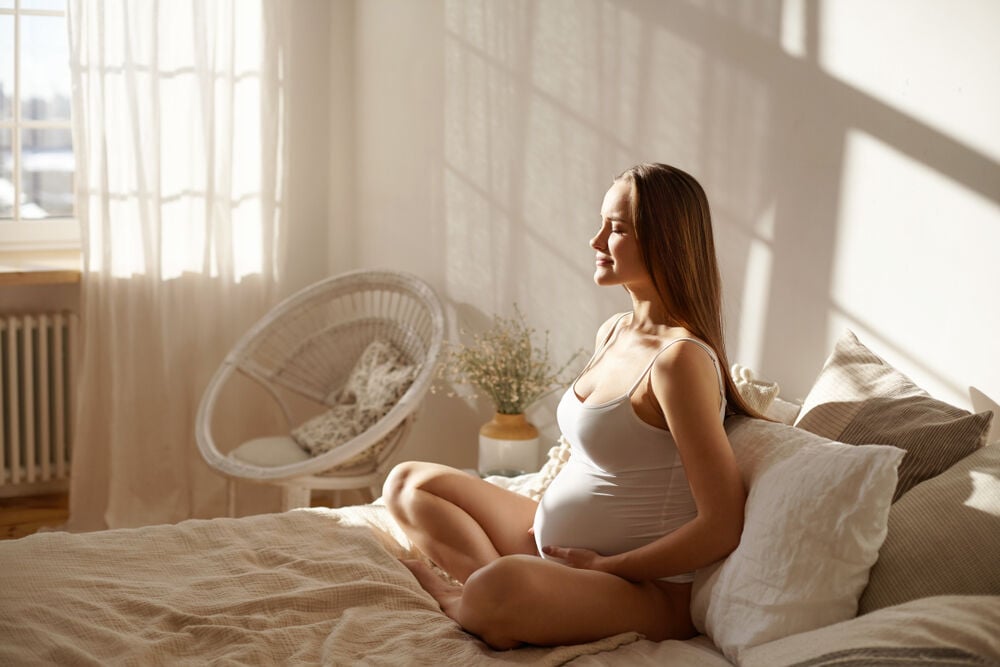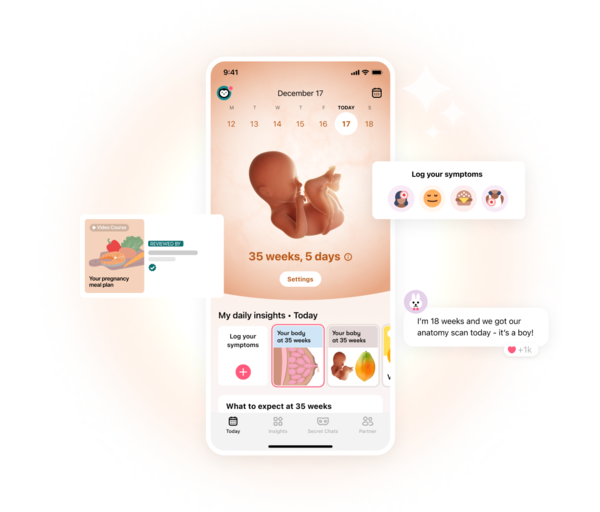Congratulations, momma! You’ve probably heard that you’re “glowing.” It’s not just the emotional joy of pregnancy, though. With a different balance of hormones and other physical changes to your skin and hair, there’s actually a scientific basis to pregnancy glow.
-
Tracking cycle
-
Getting pregnant
-
Pregnancy
-
Help Center
-
Flo for Partners
-
Anonymous Mode
-
Flo app reviews
-
Flo Premium New
-
Secret Chats New
-
Symptom Checker New
-
Your cycle
-
Health 360°
-
Getting pregnant
-
Pregnancy
-
Being a mom
-
LGBTQ+
-
Quizzes
-
Ovulation calculator
-
hCG calculator
-
Pregnancy test calculator
-
Menstrual cycle calculator
-
Period calculator
-
Implantation calculator
-
Pregnancy weeks to months calculator
-
Pregnancy due date calculator
-
IVF and FET due date calculator
-
Due date calculator by ultrasound
-
Medical Affairs
-
Science & Research
-
Pass It On Project New
-
Privacy Portal
-
Press Center
-
Flo Accuracy
-
Careers
-
Contact Us
Pregnancy Glow Explained or How Pregnancy Can Affect Your Looks


Every piece of content at Flo Health adheres to the highest editorial standards for language, style, and medical accuracy. To learn what we do to deliver the best health and lifestyle insights to you, check out our content review principles.
What is pregnancy glow?
Pregnancy glow refers to skin that looks luminous or rosy cheeks that give you a radiant, slightly flushed look. During pregnancy, the amount of blood in your body increases by about 50 percent, making your skin look brighter. This increased circulation can give you an all-over flushed appearance, which many pregnant women look forward to.
What causes pregnancy glow?
When you’re pregnant, your body shifts the production of certain hormones, such as progesterone, increasing the amount of oil that your skin produces. These hormonal shifts cause your skin to look brighter.
The increase in blood flow and extra volume also make your skin brighter. Pregnancy causes most women to have improved circulation, which can give you clearer skin. Increased blood flow means more blood in your blood vessels, which makes many women appear flushed. You may also notice that areas on your body with thinner skin, such as your chest and breasts, appear flushed as well.
What exact changes in appearance can you expect during pregnancy?
Glowing skin isn’t the only change in your appearance you can expect when you’re pregnant. Increased blood flow may also cause your veins to appear more pronounced all over your body. The increased blood volume makes the veins larger and darker.
Pregnancy hormones and some of the vitamins and minerals in prenatal supplements can also cause changes in your appearance.
Face and skin
Your face and skin may look flushed and shiny. Increased blood flow gives you a rosier appearance, and extra progesterone increases oil production.
For women with naturally oily skin, the extra oil may cause breakouts and pimples. Women who experience acne flare-ups prior to menstruation may be especially vulnerable to pregnancy acne breakouts. Check with your doctor about a pregnancy-friendly cleanser and topical creams that can reduce breakouts.
About 50 percent of women also experience something called the “mask of pregnancy.” The scientific name for this condition is melasma and chloasma. The increase in hormones during pregnancy can increase the levels of pigmentation in your skin, resulting in darker splotches on your face, usually on the forehead and cheeks.
Women who experience acne flare-ups prior to menstruation may be especially vulnerable to pregnancy acne breakouts.
Sun exposure can increase the appearance of melasma. Be sure to wear sunscreen of at least SPF 15 on your face, and consider wearing a hat when you’re outside.
Your belly and breasts will grow over the course of your pregnancy. Many women experience stretch marks on their breasts, hips, and stomach during pregnancy. Stretch marks are caused when your skin grows quickly and look like pink or red streaks along your body.
Drinking plenty of water, engaging in light exercise (as approved by your ob-gyn), and moisturizing with lotions that contain vitamin E may reduce the appearance of stretch marks. Although these remedies haven’t been medically proven to have a direct effect on stretch marks, it never hurts to try.
Breasts
Many women notice that their breasts get larger during pregnancy, even as early as the first trimester. Your breasts are preparing to produce milk. As they grow and change, they might feel tender and extra sensitive. The milk ducts in your breasts are growing in anticipation of the birth, and that stretching can cause soreness.
To reduce the pain of swollen, sensitive breasts, invest in a supportive bra and avoid underwires. You may also find relief by sleeping on your side or back. If you’re a side sleeper, you may find that placing a small pillow between your breasts helps reduce the painful, swollen feeling when you wake up.
You may see stretch marks along the sides of your breasts. Darker, more pronounced nipples and larger, darker areolas are also common. Pregnancy hormones affect your overall skin pigmentation. It’s also thought that the darker nipple area makes it easier for newborn babies to see where to latch on.
Toward the end of your pregnancy, your nipples may start to leak a yellowish fluid known as colostrum. This may occur more if your breasts are stimulated sexually or through pressure from your bra or shirt. If you don’t produce colostrum, don’t worry. You should still be able to produce milk for your baby.
Some women may notice lumps or bumps on their breasts. You have small glands on your areolas called Montgomery’s tubercles. These may become larger and more pronounced during pregnancy.
You may also notice lumps in your breasts as you do monthly self-exams. If they appear red and are tender to the touch, they’re most likely clogged milk ducts, common in pregnancy. You can try placing warm compresses over the bumps to reduce the swelling and allow the clog to break apart. However, any lump should be discussed with your doctor.
Hair and nails
Take a quiz
Find out what you can do with our Health Assistant

Longer, shinier hair and stronger, faster-growing nails are a side effect of pregnancy that many women enjoy. Taking folic acid, usually recommended by ob-gyns, often promotes faster hair growth. In addition, pregnancy hormones reduce the natural shedding of hair during pregnancy, making your hair look thicker and fuller. After childbirth, all that extra growth may fall out, though, as your hormone levels shift back to normal.
You may also notice darker and more prolific body hair during pregnancy. This hair is also subject to the same influences as the hair on your head. Most hair removal techniques are considered safe during pregnancy. It’s usually better to stay away from laser hair removal and electrolysis during pregnancy, so make sure to check with your doctor if you’re considering it. To get rid of stray hairs, you can safely tweeze, wax, or shave. Avoid chemicals such as bleaches or depilatories, which could be absorbed into your bloodstream. Keep in mind that waxing your bikini area may be more painful than usual. The increased blood flow that goes along with pregnancy can make your skin more sensitive.
Changes in your nails are also part of pregnancy. While some women enjoy stronger, broader nails, others notice that their nails are more brittle, flaky, or break more easily. Your individual hormones control whether your nails change and to what degree. If your nails are more brittle, consider wearing gloves when cleaning or washing dishes.
How long does pregnancy glow last?
Every woman and each pregnancy is different. Some pregnant women “glow” for the entire nine months, while others have a more noticeable change in the first or second trimester. Your own hormone levels will control how long and how intense your pregnancy glow is.
For most women, there’s no set time frame for their glow. However, most women tend to be extra radiant during the second trimester as the changes in their body become more intense.
After birth, your hormone levels will change again. This will cause much of the glow to subside as your blood volume returns to pre-pregnancy levels. Not every woman’s skin is noticeably affected by pregnancy, and some of your inner glow may simply be your own happiness.
Does pregnancy glow happen to everyone?

Pregnancy glow may not affect every woman. While all pregnant women will have higher blood flow and volume, the degree to which pregnancy glow shows on their skin varies.
If pregnancy glow, whether from oilier skin or a rosier complexion, doesn’t happen to you, don’t worry. It just means that the shifting hormones aren’t affecting your skin in that way.
Can pregnancy negatively affect skin?
Women with naturally oily skin may notice increased breakouts during pregnancy. Even women who typically don’t get blemishes or pimples may notice that they’re breaking out more. Be sure to drink plenty of water and eat a healthy diet. Eating overly processed foods may make breakouts worse.
Women with chronic skin conditions, such as rosacea or eczema, may notice that the hormonal changes of pregnancy make the symptoms of these skin conditions worse.
Other skin conditions, such as spider veins and varicose veins, may be caused by the increased blood flow during pregnancy. Spider veins typically go away, shrink, or fade after delivery. Varicose veins may be more common if you have a family history of them. Make sure to wear compression stockings, take vitamin C, and elevate your feet after being on them for long periods of time.
Finally, the excess pigmentation in your skin can cause your moles and other darker spots to get even darker. It’s generally completely normal for moles, freckles, and birthmarks to get darker during pregnancy. It’s always a good idea, though, to check with a dermatologist or physician about unusual changes in size, color, or shape.
During pregnancy, changing hormones can cause changes in your skin and overall experience, giving you a glow. These changes are generally temporary and can give you shinier hair and rosier cheeks.


Hey, I'm Anique
I started using Flo app to track my period and ovulation because we wanted to have a baby.


The Flo app helped me learn about my body and spot ovulation signs during our conception journey.


I vividly
remember the day
that we switched
Flo into
Pregnancy Mode — it was
such a special
moment.
Real stories, real results
Learn how the Flo app became an amazing cheerleader for us on our conception journey.
References
History of updates
Current version (27 November 2020)
Published (14 August 2019)
In this article

Get your personal guide to pregnancy with the Flo app
-
Follow your baby's growth week by week
-
Get expert info on symptoms, safe foods, and more
-
Chat with other parents-to-be




